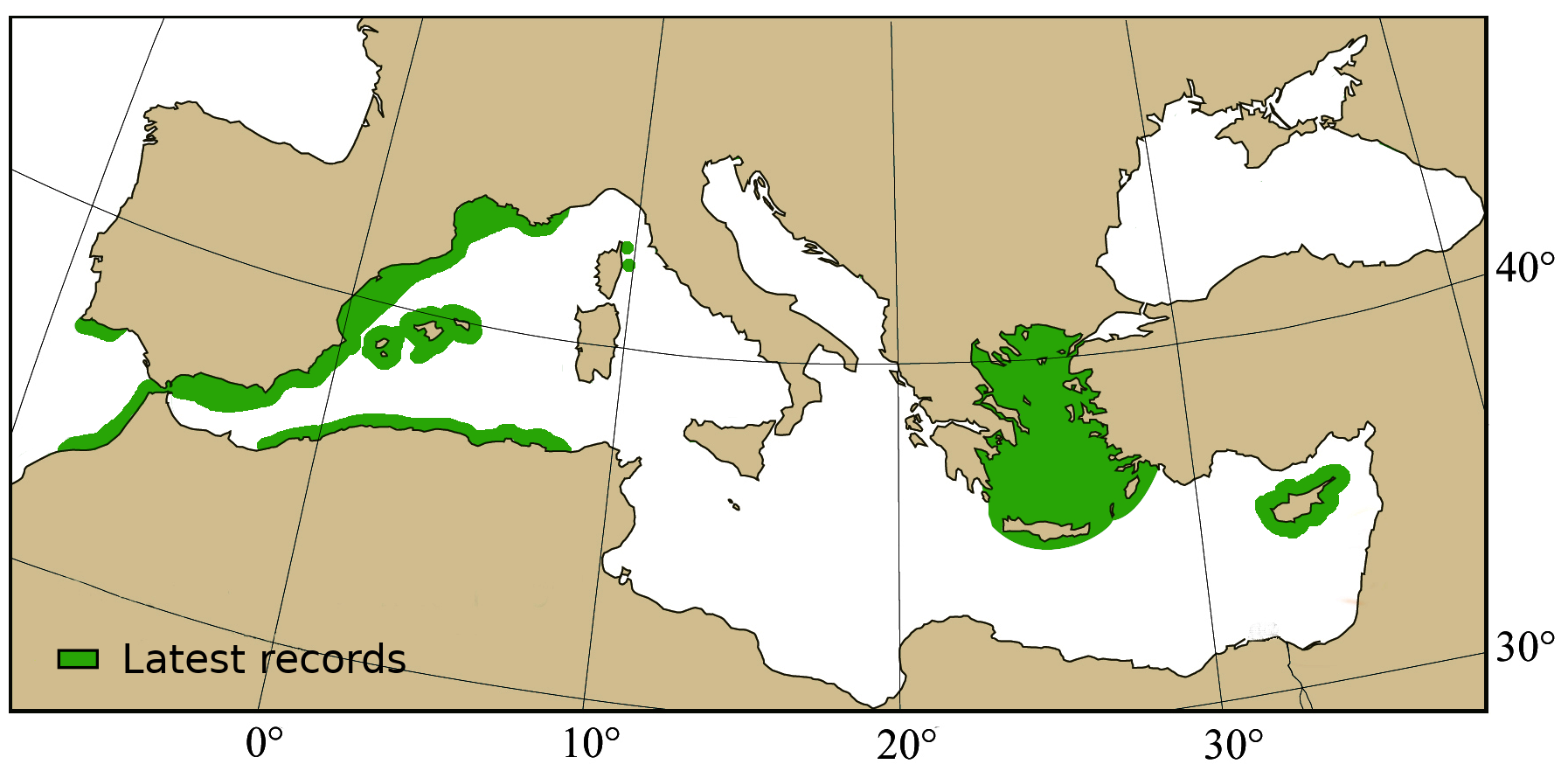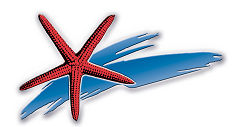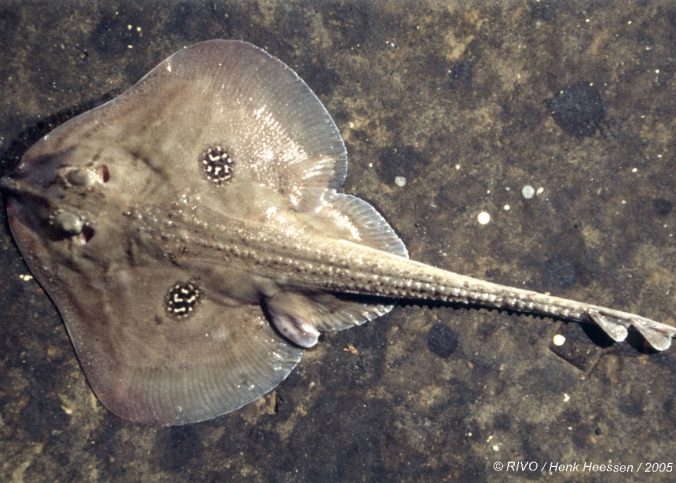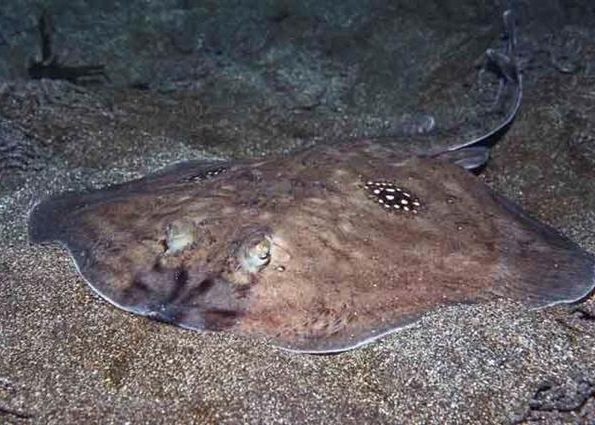Leucoraja naevus
Common name : Cuckoo ray
Order: Rajiformes
Family: Rajidae
Synonyms: Raja naevus
Misidentifications: None
Short description
Medium-sized skate. Rhomboid disk, slightly wider than long, with sinuous anterior margins. Short and pointed muzzle. Upper surface entirely spinulose, smooth in juveniles. Underside smooth except for the snout. Row of 9-13 thorns around ocella and large triangle of thorns on shoulders. Two parallel rows of spines along the tail.
Color: Dorsal surface ochre to light greyish-brown. A large black ocella with yellow marbling in the middle of each pectoral fin. Secondary ocella may be present on other parts of the disc. White ventrally.
Measurements:
- Total length (TL): 40 – 60 cm (max 81 cm male, 68 cm female)
Swimming pattern: Undulatory and pelvic fin locomotion (walking and punting).
Egg case
Rectangular shape and pointed horns at the corners, deposited in sandy or muddy bottoms.
Size: 5-7 cm length, 3.1 – 3.9 cm wide
Distinctive features:
- Length of the anterior horns about 3 times that of the rear horns
Leucoraja: Egg case with long pointed horns. Anterior horns length greater than twice the posterior. Rear horns relatively long.

Rajiformes / Rajidae: Rectangular egg-case, width no greater than twice the capsule length.
Biology / Ecology
Feeds on all kinds of bottom animals.
Reproduction: Oviparous. Size at maturity (TL): 45 – 71.8 cm. Gestation period: 8 months. Eggs per year: 70-150. Size at birth (TL): 9 – 12 cm.
Habitat: Demersal and offshore species (benthic in coastal water) on coarse sand and gravel substrate at depth from 10 to 900 m (usually 20 – 250 m).
Always been relatively uncommon in the Mediterranean Sea.
Distinguishing characteristics
- Short snout.
- Black ocella marbled with yellow marbling.
- Two rows of spines along the tail.
Rajiformes / Rajidae: Depressed body. Circular to rhombic disc. Tail well demarcated from disc.
Distribution
Worldwide: Eastern Atlantic from Norway to Senegal. Absent from Black Sea.
Mediterranean: Whole Mediterranean.
- Occurrence: Occasional/rare. Most frequently captured in the Aegean Sea.
- Latest records: Portugal (1986-2017), Atlantic – Morocco (2015,2016), Aegean Sea (2012-2015), Balearic islands (2012-2015), Cyprus (2012-2015), Gulf of Lion – France (2012-2015),Crete (2012-2015), Spain (2012-2015), Izmir, Sigacik & Edremit bay – Turkey (2007-2009), Algeria (2003-2004).

Any recent observation not on the map?
Contact us!
Conservation
Threats: Taken as bycatch with bottom trawlers.
Protection level:
- Mediterranean: Near Threatened (IUCN 2016, last assessment: 2016)
- Global, Europe: Least Concern (IUCN 2015, last assessment: 2014)
Key references
- Carpentieri P., Nastasi A., Sessa M., Srour A. 2021. Incidental catch of vulnerable species in mediterranean and black sea fisheries a review. General Fisheries Commission for the Mediterranean – Studies and Reviews 101: I-317.
- Eronat EGT, Özaydın, O., 2014. Length-weight relationship of cartilaginous fish species from Central Aegean Sea (Izmir Bay and Sığacık Bay). Ege J FishAqua Sci 31(3): 119-125.
- Follesa M. C., Marongiu M. F., Zupa W., Bellodi A., Cau A., Cannas R., Colloca F., Djurovic M., Isajlovic I., Jadaud A., Manfredi C., Mulas A., Peristeraki P., Porcu C., Ramirez-Amaro S., Salmerón Jiménez F., Serena F., Sion L., Thasitis I., Cau A., Carbonara P. 2019. Spatial variability of Chondrichthyes in the northern Mediterranean. Scientia Marina 83(S1): 81-100.
- Giovos I., Serena F., Katsada D., Anastasiadis A., Barash A., Charilaou C., Hall-Spencer J.M.,Crocetta F.,Kaminas A., Kletou D, Maximiadi M., Minasidis V., Moutopoulos D.K., Aga-Spyridopoulou R.N., Thasitis I., Kleitou P. 2021. Integrating literature, biodiversity databases, and citizen-science to reconstruct the checklist of Chondrichthyans in Cyprus (Eastern Mediterranean Sea). Fishes 6(3): 24.
- Marongiu M.F., Porcu C., Bellodi A., Cannas R., Cau A., Cuccu D., Mulas A., Follesa M.C. 2017. Temporal dynamics of demersal chondrichthyan species in the central western Mediterranean Sea: The case study in Sardinia Island. Fisheries Research 193: 81-94.
- Türker, Dilek & Zengin, Kadriye & Tunay, Özgür Kemal. 2018. Length-Weigth Relationships for Nine Chondrichthyes Fish Species from Edremit Bay (North Aegean Sea). Turkish Journal of Fisheries and Aquatic Sciences 19: 71-79.



